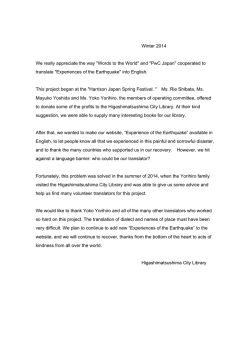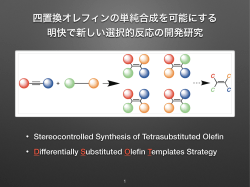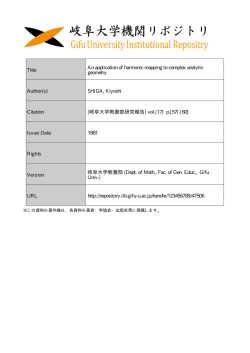
デーン不変量 と ヒルの四面体
デーン不変量 と ヒルの四面体 S. Kusafusa ヒルの四面体 ヒルベルト (Hilbert) の第3問題: 底面積と高さの等しい4面体(三角 錐) の一方を有限個の小多面体に分けて、それらを寄せ合わせて他 方の4面体を作ることは一般に不可能であることを示せ. (1900 年 パリ国際数学者会議でヒルベルトが23の「数学の問題」をリス ト アップして20世紀の数学の目標を与えた) ヒルベルトの第3問題は、デーン不変量で知られる弟子のデン (Dehn)によって解決された. すなわちデンは「正4面体(regular tetrahedron)を小多面体に分けてそれらを寄せ 集めて立方体を作る ことはできない」ことを示した. しかし、特別な四面体であるヒル の4面体(Hill's tetrahedron)から立方体を作ることができる. した がって、ヒルベルトの第3問題が解決されたことになるのである. Hill's tetrahedra The third on Hilbert's list of mathematical problems, presented in 1900, was the first to be solved. The problem is related to the following question: given any two polyhedra of equal volume, is it always possible to cut the first into finitely many polyhedral pieces which can be reassembled to yield the second? Based on earlier writings by Gauss, Hilbert conjectured that this is not always possible. This was confirmed within the year by his student Max Dehn, who proved that the answer in general is "no" by producing a counterexample. The answer for the analogous question about polygons in 2 dimensions is "yes" and had been known for a long time; this is the Bolyai–Gerwien theorem. In geometry, the Hill's tetrahedra are a family of space-filling tetrahedra. They were discovered in 1896 by M. J. M. Hill, a professor of mathematics at the University College London, who showed that they are scissor-congruent to a cube. ボヤイ=ゲルヴィンの定理 (Bolyai–Gerwien theorem) バナッハ-タルスキー定理 選択公理 S. Kusafusa
© Copyright 2026




